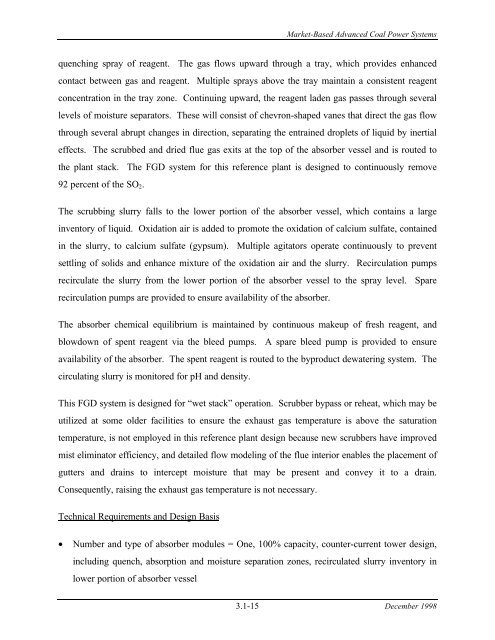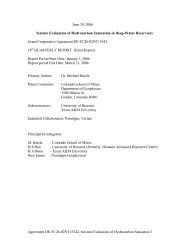- Page 1 and 2: DOE/FE-0400 MARKET-BASED ADVANCED C
- Page 3 and 4: Section 1, Introduction 2000 1500 1
- Page 5 and 6: Section 1, Introduction the issues
- Page 7 and 8: Section 1, Introduction 1.3 REPORT
- Page 9 and 10: Section 1, Introduction This page l
- Page 11 and 12: Section 2, General Evaluation Basis
- Page 13 and 14: Section 2, General Evaluation Basis
- Page 15 and 16: Section 2, General Evaluation Basis
- Page 17 and 18: 3. PULVERIZED COAL Market-Based Adv
- Page 20 and 21: Section 3.1, PC-Fired Subcritical P
- Page 22 and 23: Section 3.1, PC-Fired Subcritical P
- Page 24 and 25: Section 3.1, PC-Fired Subcritical P
- Page 26 and 27: Section 3.1, PC-Fired Subcritical P
- Page 28 and 29: Section 3.1, PC-Fired Subcritical P
- Page 32 and 33: Section 3.1, PC-Fired Subcritical P
- Page 34 and 35: Section 3.1, PC-Fired Subcritical P
- Page 36 and 37: Section 3.1, PC-Fired Subcritical P
- Page 38 and 39: Section 3.1, PC-Fired Subcritical P
- Page 40 and 41: Section 3.1, PC-Fired Subcritical P
- Page 42 and 43: Section 3.1, PC-Fired Subcritical P
- Page 44 and 45: Section 3.1, PC-Fired Subcritical P
- Page 46 and 47: Section 3.1, PC-Fired Subcritical P
- Page 48 and 49: Section 3.1, PC-Fired Subcritical P
- Page 50 and 51: Section 3.1, PC-Fired Subcritical P
- Page 52 and 53: Market-Based Advanced Coal Power Sy
- Page 55 and 56: Section 3.2, PC-Fired Supercritical
- Page 57 and 58: Section 3.2, PC-Fired Supercritical
- Page 59 and 60: Section 3.2, PC-Fired Supercritical
- Page 61 and 62: Section 3.2, PC-Fired Supercritical
- Page 63 and 64: Section 3.2, PC-Fired Supercritical
- Page 65 and 66: Section 3.2, PC-Fired Supercritical
- Page 67 and 68: Section 3.2, PC-Fired Supercritical
- Page 69 and 70: Section 3.2, PC-Fired Supercritical
- Page 71 and 72: Section 3.2, PC-Fired Supercritical
- Page 73 and 74: Section 3.2, PC-Fired Supercritical
- Page 75 and 76: Section 3.2, PC-Fired Supercritical
- Page 77 and 78: Section 3.2, PC-Fired Supercritical
- Page 79 and 80: Section 3.2, PC-Fired Supercritical
- Page 81 and 82:
Section 3.2, PC-Fired Supercritical
- Page 83 and 84:
Section 3.2, PC-Fired Supercritical
- Page 85 and 86:
Section 3.2, PC-Fired Supercritical
- Page 87 and 88:
Section 3.2, PC-Fired Supercritical
- Page 89 and 90:
Section 3.2, PC-Fired Supercritical
- Page 91 and 92:
Section 3.2, PC-Fired Supercritical
- Page 93 and 94:
Market-Based Advanced Coal Power Sy
- Page 96 and 97:
Section 3.3, PC-Fired Ultra-Supercr
- Page 98 and 99:
Section 3.3, PC-Fired Ultra-Supercr
- Page 100 and 101:
Section 3.3, PC-Fired Ultra-Supercr
- Page 102 and 103:
Section 3.3, PC-Fired Ultra-Supercr
- Page 104 and 105:
Section 3.3, PC-Fired Ultra-Supercr
- Page 106 and 107:
Section 3.3, PC-Fired Ultra-Supercr
- Page 108 and 109:
Section 3.3, PC-Fired Ultra-Supercr
- Page 110 and 111:
Section 3.3, PC-Fired Ultra-Supercr
- Page 112 and 113:
Section 3.3, PC-Fired Ultra-Supercr
- Page 114 and 115:
Section 3.3, PC-Fired Ultra-Supercr
- Page 116 and 117:
Section 3.3, PC-Fired Ultra-Supercr
- Page 118 and 119:
Section 3.3, PC-Fired Ultra-Supercr
- Page 120 and 121:
Section 3.3, PC-Fired Ultra-Supercr
- Page 122 and 123:
Section 3.3, PC-Fired Ultra-Supercr
- Page 124 and 125:
Section 3.3, PC-Fired Ultra-Supercr
- Page 126 and 127:
Section 3.3, PC-Fired Ultra-Supercr
- Page 128 and 129:
Section 3.3, PC-Fired Ultra-Supercr
- Page 130 and 131:
4. INTEGRATED GASIFICATION COMBINED
- Page 132 and 133:
Market-Based Advanced Coal Power Sy
- Page 135 and 136:
Section 4.1, First-of-a-Kind IGCC,
- Page 137 and 138:
Section 4.1, First-of-a-Kind IGCC,
- Page 139 and 140:
Section 4.1, First-of-a-Kind IGCC,
- Page 141 and 142:
Section 4.1, First-of-a-Kind IGCC,
- Page 143 and 144:
Section 4.1, First-of-a-Kind IGCC,
- Page 145 and 146:
Section 4.1, First-of-a-Kind IGCC,
- Page 147 and 148:
Section 4.1, First-of-a-Kind IGCC,
- Page 149 and 150:
Section 4.1, First-of-a-Kind IGCC,
- Page 151 and 152:
Section 4.1, First-of-a-Kind IGCC,
- Page 153:
Section 4.1, First-of-a-Kind IGCC,
- Page 156 and 157:
4.1.10 Equipment List - Major ACCOU
- Page 158 and 159:
Market-Based Advanced Coal Power Sy
- Page 160 and 161:
ACCOUNT 4 BOILER AND ACCESSORIES AC
- Page 162 and 163:
ACCOUNT 6 COMBUSTION TURBINE AND AU
- Page 164 and 165:
ACCOUNT 9 COOLING WATER SYSTEM Equi
- Page 166 and 167:
Section 4.1, First-of-a-kind IGCC,
- Page 168 and 169:
Section 4.2 Market-Based Intermedia
- Page 170:
Section 4.2, Market-Based Intermedi
- Page 173 and 174:
Market-Based Advanced Coal Power Sy
- Page 175 and 176:
Market-Based Advanced Coal Power Sy
- Page 177 and 178:
Market-Based Advanced Coal Power Sy
- Page 179 and 180:
Market-Based Advanced Coal Power Sy
- Page 181 and 182:
4.2.4.7 Gas Turbine Generator Marke
- Page 183 and 184:
Market-Based Advanced Coal Power Sy
- Page 185 and 186:
Market-Based Advanced Coal Power Sy
- Page 187 and 188:
4.2.6.4 Circulating Water System Ma
- Page 190 and 191:
Section 4.2, Market-Based Intermedi
- Page 192 and 193:
Section 4.2, Market-Based Intermedi
- Page 194 and 195:
Section 4.2, Market-Based Intermedi
- Page 196 and 197:
Section 4.2, Market-Based Intermedi
- Page 198 and 199:
Section 4.2, Market-Based Intermedi
- Page 200 and 201:
Section 4.2, Market-Based Intermedi
- Page 202 and 203:
Section 4.2, Market-Based Intermedi
- Page 204 and 205:
4.3 ADVANCED AIR-BLOWN TRANSPORT RE
- Page 207 and 208:
Section 4.3, Advanced IGCC Reserved
- Page 209 and 210:
Section 4.3, Advanced IGCC The Rank
- Page 211 and 212:
Section 4.3, Advanced IGCC the stea
- Page 213 and 214:
Section 4.3, Advanced IGCC The cool
- Page 215 and 216:
Section 4.3, Advanced IGCC The rege
- Page 217 and 218:
Section 4.3, Advanced IGCC 4.3.4.9
- Page 219 and 220:
Section 4.3, Advanced IGCC Technica
- Page 221 and 222:
Section 4.3, Advanced IGCC The oil
- Page 223 and 224:
Section 4.3, Advanced IGCC pumps; a
- Page 225:
Section 4.3, Advanced IGCC The arra
- Page 228 and 229:
4.3.9 Equipment List - Major ACCOUN
- Page 230 and 231:
Market-Based Advanced Coal Power Sy
- Page 232 and 233:
ACCOUNT 4 BOILER AND ACCESSORIES AC
- Page 234 and 235:
ACCOUNT 5D PARTICULATE REMOVAL Equi
- Page 236 and 237:
ACCOUNT 7 WASTE HEAT BOILER, DUCTIN
- Page 238 and 239:
ACCOUNT 9 COOLING WATER SYSTEM Equi
- Page 240 and 241:
Section 4.3, Advanced IGCC Market-B
- Page 242 and 243:
Section 4.4 Market-Based Advanced O
- Page 244:
Section 4.2, Market-Based Intermedi
- Page 247 and 248:
Market-Based Advanced Coal Power Sy
- Page 249 and 250:
Market-Based Advanced Coal Power Sy
- Page 251 and 252:
4.4-9 December 1998 Coal Water Coal
- Page 253 and 254:
Market-Based Advanced Coal Power Sy
- Page 255 and 256:
Market-Based Advanced Coal Power Sy
- Page 257 and 258:
Market-Based Advanced Coal Power Sy
- Page 259 and 260:
Market-Based Advanced Coal Power Sy
- Page 261 and 262:
4.4.6.3 Main and Reheat Steam Syste
- Page 263 and 264:
4.4.8 Instrumentation and Control M
- Page 265 and 266:
4.4.10 Equipment List - Major ACCOU
- Page 267 and 268:
Market-Based Advanced Coal Power Sy
- Page 269 and 270:
ACCOUNT 4 BOILER AND ACCESSORIES AC
- Page 271 and 272:
ACCOUNT 7 WASTE HEAT BOILER, DUCTIN
- Page 273 and 274:
4.4.11 Conceptual Capital Cost Esti
- Page 275 and 276:
5. CIRCULATING PFBC, SECOND GENERAT
- Page 278 and 279:
Section 5, CPFBC Reserved for rever
- Page 280 and 281:
Section 5, CPFBC The steam turbine
- Page 282 and 283:
Section 5, CPFBC are ducted to an M
- Page 284 and 285:
Section 5, CPFBC Flue gases and ent
- Page 286 and 287:
Section 5, CPFBC The boost compress
- Page 288 and 289:
Section 5, CPFBC 5.5 PFBC SUPPORT S
- Page 290 and 291:
Section 5, CPFBC to two day bins of
- Page 292 and 293:
Section 5, CPFBC returns to the FBH
- Page 294 and 295:
Section 5, CPFBC Cold reheat steam
- Page 296:
Section 5, CPFBC 5.8 INSTRUMENTATIO
- Page 299 and 300:
Market-Based Advanced Coal Power Sy
- Page 301 and 302:
Market-Based Advanced Coal Power Sy
- Page 303 and 304:
Market-Based Advanced Coal Power Sy
- Page 305 and 306:
ACCOUNT 4 PFBC BOILER AND ACCESSORI
- Page 307 and 308:
ACCOUNT 7 WASTE HEAT BOILER, DUCTIN
- Page 309 and 310:
5.11 CONCEPTUAL CAPITAL COST ESTIMA
- Page 311 and 312:
6. NATURAL GAS COMBINED CYCLE (NGCC
- Page 313 and 314:
Market-Based Advanced Coal Power Sy
- Page 316:
Section 6.1, Market-Based NGCC Rese
- Page 319 and 320:
Market-Based Advanced Coal Power Sy
- Page 321 and 322:
Table 6.1-3 AIRBORNE EMISSIONS - WE
- Page 323 and 324:
Market-Based Advanced Coal Power Sy
- Page 325 and 326:
Market-Based Advanced Coal Power Sy
- Page 327 and 328:
Market-Based Advanced Coal Power Sy
- Page 329 and 330:
Market-Based Advanced Coal Power Sy
- Page 331 and 332:
Market-Based Advanced Coal Power Sy
- Page 333 and 334:
ACCOUNT 4 PFBC BOILER AND ACCESSORI
- Page 335 and 336:
ACCOUNT 9 COOLING WATER SYSTEM Equi
- Page 337 and 338:
Market-Based Advanced Coal Power Sy
- Page 339 and 340:
ACCOUNT 7 WASTE HEAT BOILER, DUCTIN
- Page 341 and 342:
6.1.12 Conceptual Capital Cost Esti
- Page 343 and 344:
Section 6.1, NGCC Market-Based Adva
- Page 345 and 346:
7. INSTRUMENTATION AND CONTROLS Mar
- Page 347 and 348:
Market-Based Advanced Coal Power Sy
- Page 349 and 350:
8. ANALYSIS OF ENVIRONMENTAL UNCERT
- Page 351 and 352:
Market-Based Advanced Coal Power Sy
- Page 353 and 354:
Market-Based Advanced Coal Power Sy
- Page 355 and 356:
Market-Based Advanced Coal Power Sy
- Page 357 and 358:
Market-Based Advanced Coal Power Sy
- Page 359 and 360:
Market-Based Advanced Coal Power Sy
- Page 361 and 362:
Market-Based Advanced Coal Power Sy
- Page 363 and 364:
Market-Based Advanced Coal Power Sy
- Page 365 and 366:
Market-Based Advanced Coal Power Sy
- Page 367 and 368:
TABLE 9-2 CASE COMPARISON - COST DA
- Page 369 and 370:
Market-Based Advanced Coal Power Sy
- Page 371 and 372:
• Maintenance - Material - Labor
- Page 373 and 374:
TABLE 9-3 CASE COMPARISONS - SELECT

















